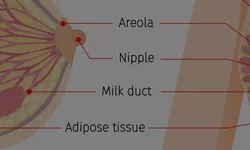This article is part of a series on breast milk's nutrition facts.
Are colostrum's nutrition facts the same as breast milk?
Q: Why does our body make a different type of breast milk for newborns? How does colostrum's composition differ from "normal" breast milk?
A: Colostrum refers to the very first milk you express right after you give birth. You recognize it by its characteristic yellow-orange color.
Colostrum lasts from anywhere between 2 and 5 days. Your milk then becomes "transitional milk" before becoming mature.
Colostrum's composition is quite different from mature breast milk. It's substantially lower in calories with only about 16 kcal per ounce (30ml) of colostrum vs 20-22 kcal for mature milk.

Colostrum (left) versus mature milk (right)
That's because it contains more water and less fat than mature milk with 90% water and only 2.2% fats (half that of mature milk). It also contains less carbohydrates with about 5.6% (vs 7.5% for mature milk). It contains more proteins though with about 2.5% versus only 1.1% for mature milk.
It also differs substantially in the amount of minerals, vitamins, antibodies and white blood cells. In fact it has so many antibodies and white blood cells that it's often referred to as your baby's "first vaccine". Between 13% and 70% of colostrum's total cells are white blood cells, the cells of the immune system designed to protect the body against invasions1.
It also packs a punch in terms of minerals and vitamins versus mature breast milk. It's particularly high in β-Carotenes (pronounce "beta-carotenes") which is where it derives its characteristic yellow-orange color. There is around 10 times more β-Carotenes in colostrum than in mature breast milk.
β-Carotenes contribute to the vitamin A needs of your baby2 and exert important functions in immunity, in the antioxidant defense system, and are related to a reduced risk of developing chronic diseases.3
To recover from giving birth and improve the nutritional value of your milk, we recommend you drink Milk Boost Tea. It's an ancestral recipe of 13 natural herbs that's been used for centuries by nursing mothers.

Milk Boost Tea is a natural herbal tea that can help you improve your milk volume and its nutritional value
Among its 13 ingredients Milk Boost Tea contains Dong Quai, a root also known as the "female ginseng" for its wide range of health benefits for women. It also contains Longans, famous for nourishing the blood and helping nursing women recover from childbirth.
You might also be interested by the other articles in our series about breast milk's nutrition facts:
- How many calories are there in breast milk?
- What are breast milk's nutrition facts? What is it composed of?
- Why is fat so important in breast milk?
- Does formula have more calories than breast milk?
- How much proteins are there in breast milk?
- How much carbohydrates are there in breast milk?
Sources:
1. Hassiotou F, Hepworth AR, Metzger P, et al. Maternal and infant infections stimulate a rapid leukocyte response in breastmilk. Clin Transl Immunology. 2013;2(4):e3. Published 2013 Apr 12. doi:10.1038/cti.2013.1
2. Stoltzfus R.J., Hakima M., Miller K.W., Rasmussen K.M., Dawiesah S.I., Habicht J.P., Dibley M.J. High dose vitamin A supplementation of breast-feeding Indonesian mothers: Effects on the vitamin A status of mother and infant. J. Nutr. 1993;123:666–675. doi: 10.1093/jn/123.4.666.
3. Bendich A. Non-provitamin A activity of carotenoids: Immunoenhancement. Trends Food Sci. Tech. 1991;2:127–130. doi: 10.1016/0924-2244(91)90648-3.
Article tags: Breastfeeding and maternity








